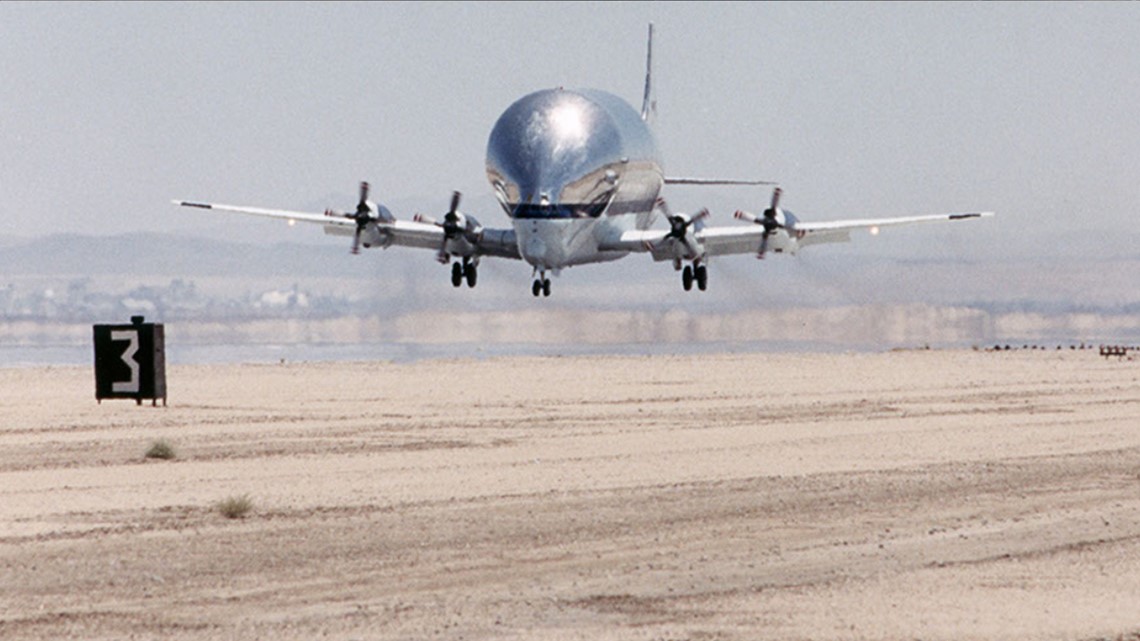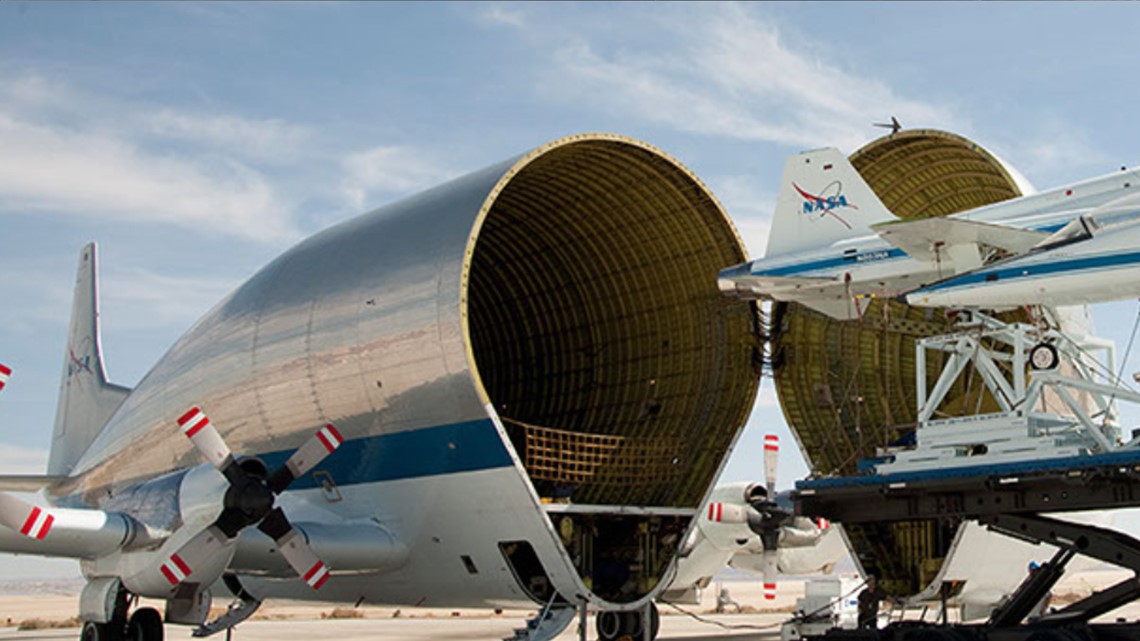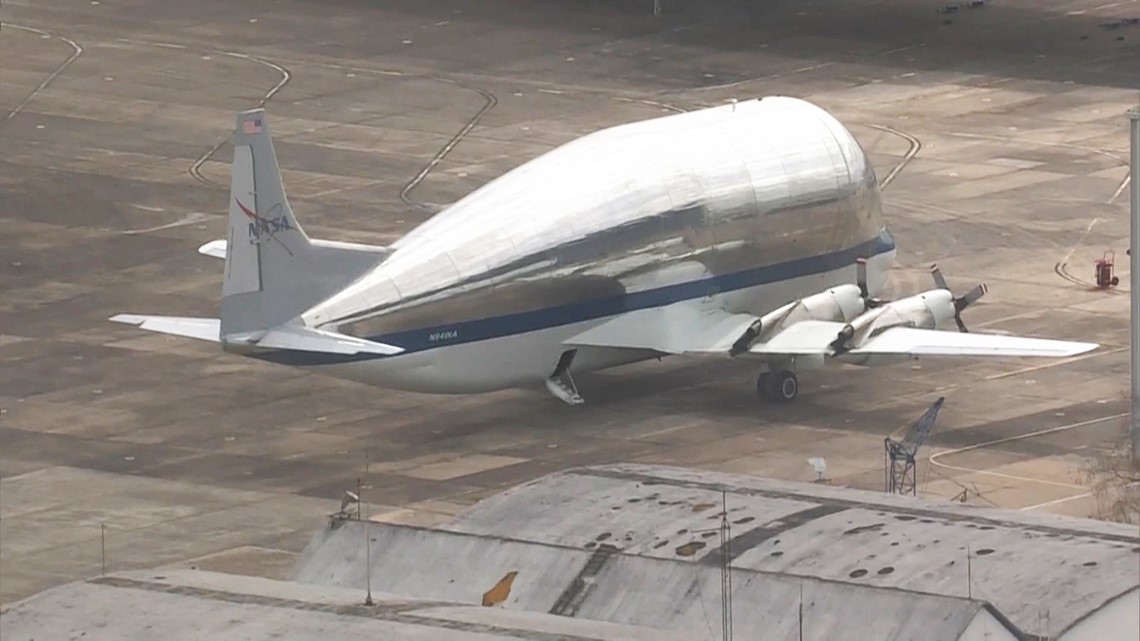HOUSTON — NASA’s cargo-transporting airplane, named the “Super Guppy,” was spotted in Houston on Thursday morning.
The large silver aircraft, which is reportedly based out of El Paso, looks like no other (although multiple variations of it have been produced). It features a large fuselage that can hold odd and large-sized cargo.
KHOU 11 viewers pointed out the plane appeared to be making several flights, landing and taking off, at Ellington Field. Online flight records showed it circled the area several times, putting on quite a show for those along the Gulf Freeway and Beltway 8-South — but also leading many to wonder what it was.
Yes, Houston is home to NASA, but not everyone gets a chance to see this unique airplane when it makes a visit.


Another viewer on the KHOU 11 Facebook page pointed out they saw the airplane in our area on Tuesday.
Read more below from NASA’s website:
Super Guppy Oversize Cargo Transport
The transportation of oversized cargo has always been a tremendous problem for logistics planners in government and private industry. The physical limitations of railroad tunnels, narrow roads, low bridges, and power lines make overland shipment of such cargo extremely problematic, if not impossible. NASA's Super Guppy offers a practical and economical solution to these problems.
Although there are other aircraft capable of carrying more weight than the Super Guppy, very few come close to its internal dimensions. Boasting an immense cargo area that is 25 feet in diameter and 111 feet long, the Super Guppy can carry items that are virtually impossible to fit inside other cargo aircraft.
The Super Guppy has a unique hinged nose that opens 110 degrees, permitting full frontal cargo loading.


A control lock and disconnect system at the fuselage break allows the nose to be opened and closed without disrupting the flight or engine control rigging.


Cargo loading is simple and efficient. There are fewer handling and shipping fixtures with a minimum of ground support equipment. A system of rails in the cargo compartment is used with either Super Guppy pallets or fixtures designed for specific cargo. Rollers mounted in the rail allow pallets or fixtures to be moved by an electric winch mounted beneath the cargo floor. Automatic hydraulic lock pins in the rail secure the pallet for flight.
Aircraft History
The transportation of oversized cargo has always been a tremendous problem for logistics planners in government and private industry. The physical limitations of railroad tunnels, narrow roads, low bridges and power lines make overland shipment of such cargo virtually impossible. NASA was particularly vexed by this problem during the early years of America’s space race, when large rocket parts destined for Cape Kennedy had to be shipped by barge through the Panama Canal or Gulf of Mexico. This amounted to a significant investment in time during a period where we had little to spare.
In 1961, California-based Aero Spaceline Industries solved this problem when it introduced the first Guppy aircraft. Built from a heavily modified KC-97 Stratotanker, the Pregnant Guppy featured the largest cargo compartment of any aircraft ever built. At just over 19’ in diameter, this massive cavity was specifically designed to carry the second stage of a Saturn rocket for the Apollo program. Because of the Pregnant Guppy, NASA was able to deliver crucial oversized cargo to the Cape in eighteen hours as opposed to 18 to 25 days aboard a barge. To say that this amazing aircraft helped America win the space race would be an understatement!
The program was so successful that ASI followed up with an even larger version of the aircraft in 1965. Dubbed the Super Guppy, it was equipped with a 25’ diameter cargo bay, more powerful engines, a pressurized cockpit, and a hinged nose for easier loading of cargo. ASI continued to own and operate the aircraft until 1979, when NASA purchased the aircraft from them. During its illustrious 32 years of service, the original Super Guppy flew over three million miles in support of NASA’s Apollo, Gemini, Skylab, and the International Space Station programs.
The Super Guppy Turbine is the last generation of Guppy aircraft ever produced and only four were ever made. The most important difference between it and its predecessor was the upgrade to more reliable and readily available Allison T-56 turboprops. Operated by Airbus Industries after they were purchased from ASI, the SGTs were used to ferry large A300 fuselage sections throughout Europe during the 70’s, 80’s, and 90’s. When Airbus retired its fleet to museums in 1997, NASA was able to acquire SGT number 4 to replace the aging Super Guppy under an International Space Station barter agreement with the European Space Alliance.
NASA’s Super Guppy Turbine continues to support America’s space program today, but with its unique capabilities it has attracted the attention of other government entities as well. In recent years, the Guppy has been working with the Department of Defense and government contractors to move aircraft and large components around the continent, including T-38s for the Air Force and V-22s for the Navy. Although much of the glory of America’s space program may be behind it, the Super Guppy continues to be one of the only practical options for oversized cargo and stands ready to encompass a bigger role in the future.

